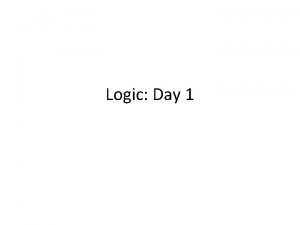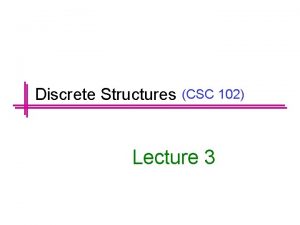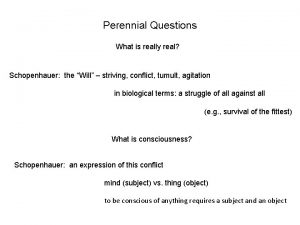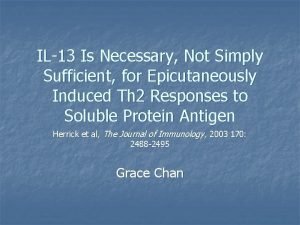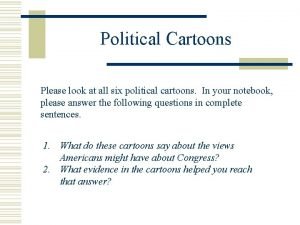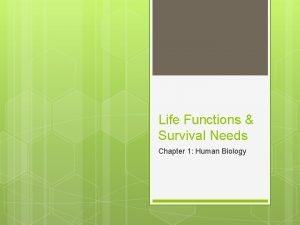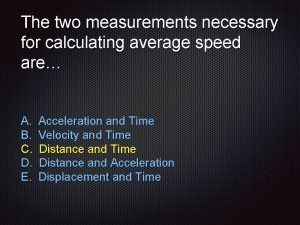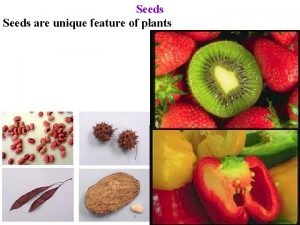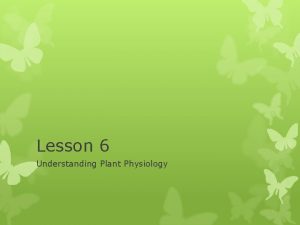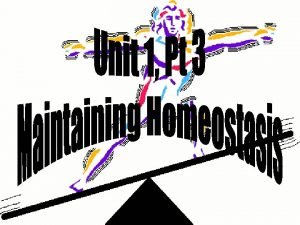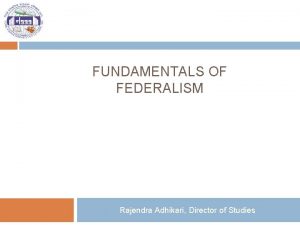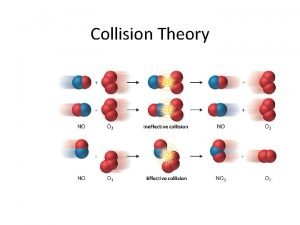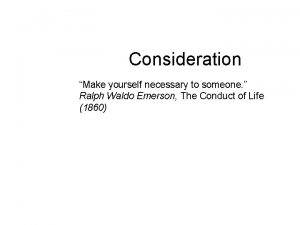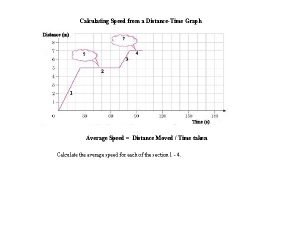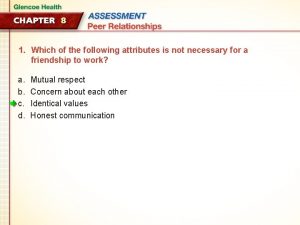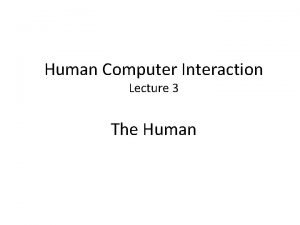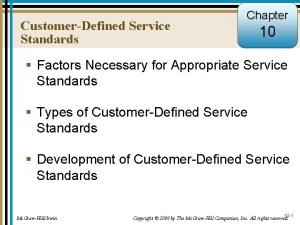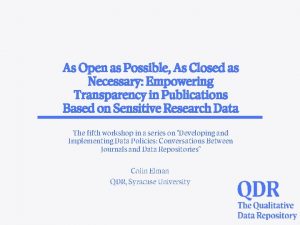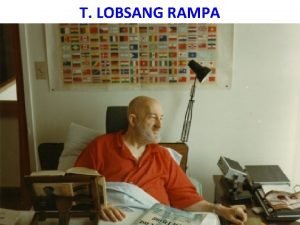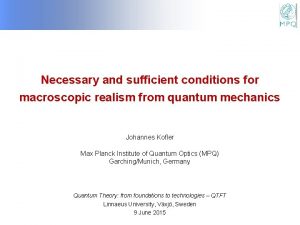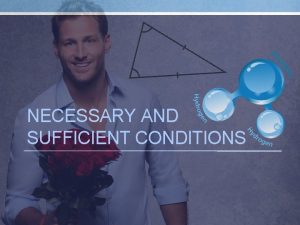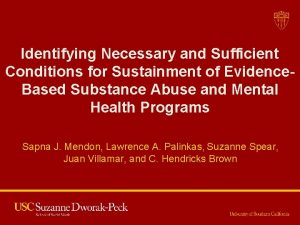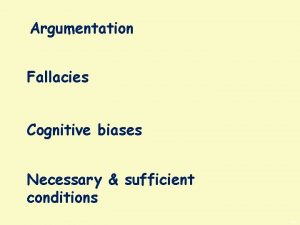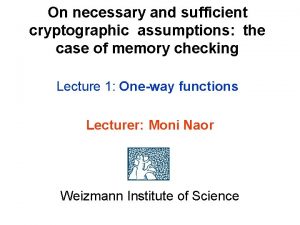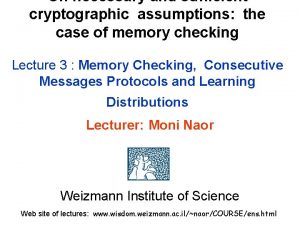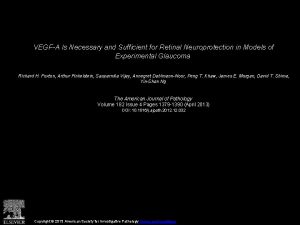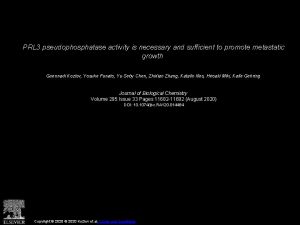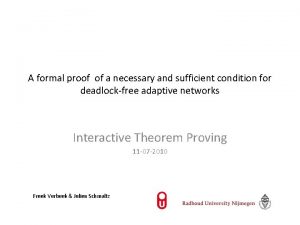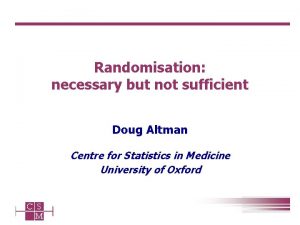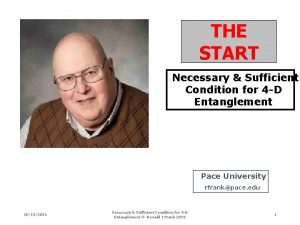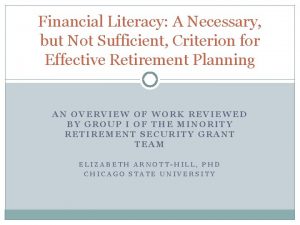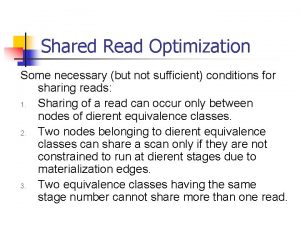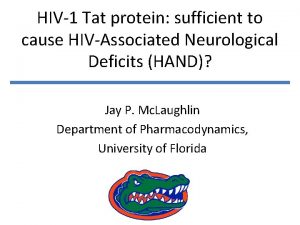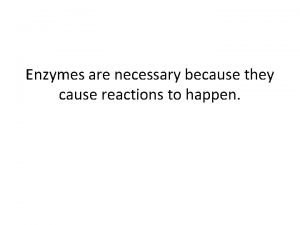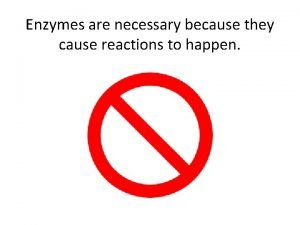10 1 Cause and Necessary and Sufficient Conditions













































- Slides: 45

10. 1 “Cause” and Necessary and Sufficient Conditions

10. 1 “Cause” and Necessary and Sufficient Conditions We can understand some causal claims as claims about necessary and sufficient conditions – but the term “cause” is ambiguous.

10. 1 “Cause” and Necessary and Sufficient Conditions “Cause” as a sufficient condition Saying that X is a cause of Y in this sense is saying that when X is present Y will also obtain. X guarantees the presence of Y. This is different from saying X must be present for Y to obtain. ◦ Example: Shooting is sufficient to cause death (but so is electrocution).

10. 1 “Cause” and Necessary and Sufficient Conditions

10. 1 “Cause” and Necessary and Sufficient Conditions “Cause” as both a necessary and sufficient condition: It being the Fourth of July is a necessary and sufficient condition for it being Independence Day in the United States.

10. 1 Continued Cause as sufficient and necessary condition summarized: ◦ A is a sufficient condition for B: A’s occurrence requires B’s occurrence, but not the other way around. ◦ A is a necessary condition for B: B’s occurrence requires A’s occurrence, but not the other way around.

10. 1 Continued However, if A occurs and B does not occur, then A is not a sufficient condition for B, and if B occurs but A does not occur, then A is not a necessary condition for B. Thus: If A is present when B is absent, A is not a If A is absent when B is present, A is not a sufficient condition for B. necessary condition for B.

10. 2 Mill’s Five Methods 19 th-century British philosopher John Stuart Mill compiled five methods for identifying causal connections between events. These five methods are: ◦ ◦ ◦ Agreement Difference Combined Agreement & Difference Residue Concomitant Variation

10. 2 The Method of Agreement is a systematic effort to find a single factor common to several occurrences in order to identify that factor as the cause of the phenomenon.

10. 2 The Method of Agreement is a systematic effort to find a single factor common to several occurrences in order to identify that factor as the cause of the phenomenon. Look at all cases where the phenomenon is present, and see if they share a common element.

10. 2 The Method of Agreement Example: 1900 -1906 Typhoid Epidemic

10. 2 The Method of Agreement Cases of typhoid were popping up in New York:

10. 2 The Method of Agreement Cases of typhoid were popping up in New York: 1900 – a family in Mamaroneck, NY become sick with typhoid symptoms 1901 – a family in Manhattan falls ill with fever and diarrhea; the laundress dies 1901 – 7/8 members of another Manhattan family fall ill 1904 – 4/10 in Long Island family get sick 1906 – 10/11 members of an Oyster Bay family fall ill with typhoid 1906 – three other households in Oyster Bay fall ill, and then the Wealthy Warren family (6/11 members infected)

10. 2 The Method of Agreement Finally a family investigated a typhoid researcher named George Soper’s reasoning used the Method of Agreement. He looked for a common factor, and realized that the cases shared one thing in common: An unmarried, middle-aged Irish cook who disappeared after each case.

10. 2 The Method of Agreement The employment history of one Ms. Mary Mallon: 1900 (Mamaroneck, NY): joins a new workplace; residents develop typhoid within two weeks of her hire 1901 (Manhattan, NY): becomes the cook for a family in the city; their laundress dies and the family develops fevers and diarrhea 1901 (Manhattan, NY): starts working for a lawyer, and leaves after 7 of the 8 household members fall ill 1904 (Long Island, NY): takes a position with another family; 4 of 10 fall ill within two weeks of her being hired

10. 2 The Method of Agreement 1906 (Oyster Bay, NY): becomes a family cook; 10 of 11 family members get sick, again within two weeks of hiring her 1906 (Oyster Bay, NY): changes jobs thrice more, and each household falls ill rapidly 1906 (Oyster Bay, NY): works as a cook for the wealthy Warren family, and they take her along to their summer house; 6/11 family members got ill

10. 2 The Method of Agreement “Typhoid” Mary – Mary Mallon – famously spread typhoid fever for years. She was the first asymptomatic carrier of the pathogen to be discovered in the US.

10. 2 The Method of Agreement A methodology in line with the method of agreement was essential for catching her. Possible Responsible Causes Case Dirty water Street hot dogs Person B Person C (Mary Mallon) Mummy-curse exposure Typhoid infection Family 1 ✓ - ✓ ✓ Family 2 - ✓ ✓ ✓ - ✓ Hospital - ✓ - ✓ Family 3 ✓ ✓ - ✓ Family 4 ✓ - ✓

10. 2 The Method of Difference

10. 2 The Method of Difference is a systematic effort to find a single factor present in an occurrence in which the phenomenon is present, and absent in an occurrence in which the phenomenon is absent.

10. 2 The Method of Difference is a systematic effort to find a single factor present in an occurrence in which the phenomenon is present, and absent in an occurrence in which the phenomenon is absent. To reiterate, it looks at a pair of cases: - One with the phenomenon present One with the phenomenon absent Trying to identify a factor present in the former, but absent in the latter.

10. 2 The Method of Difference • One twin gets lung cancer and the other doesn’t. • They’re identical twin women with the same age, still living in the same area, with a shared amniotic sack/neonatal environment and the same exposure to pathogens over their lifetime. • However, one has been a life-long smoker. Sample Possible Causes Phenomenon Occurrence Area Neonatal Pathogens Smoking Lung Cancer 1 ✓ ✓ ✓ 2 ✓ ✓ ✓ - -

10. 2 The Joint Method of Agreement & Difference

10. 2 The Joint Method of Agreement & Difference The Joint Method of Agreement and Difference is a systematic effort to find a single condition that is:

10. 2 The Joint Method of Agreement & Difference The Joint Method of Agreement and Difference is a systematic effort to find a single condition that is: present in multiple occurrences in which the phenomenon in question is present, and

10. 2 The Joint Method of Agreement & Difference The Joint Method of Agreement and Difference is a systematic effort to find a single condition that is: present in multiple occurrences in which the phenomenon in question is present, and absent in multiple occurrences in which the phenomenon is absent.

10. 2 The Joint Method of Agreement & Difference Sample Possible Causes Phenomenon Occurrence A B C D E F G Present? 1 2 3 4 5 6 ✓ ✓ ✓ ✓ ✓ - ✓ ✓ ✓ -

10. 2 The Joint Method of Agreement & Difference Sample Possible Causes Phenomenon Occurrence A B C D E F G Present? 1 2 3 4 5 6 ✓ ✓ ✓ ✓ ✓ - ✓ ✓ ✓ - Factor “E” is present in all cases where the phenomenon occurs, but no cases where it is absent.

10. 2 The Joint Method of Agreement & Difference We would be using this in the Mary Mallon case if, in addition to noting that all cases we had in common, we checked: Are there cases where she was present but typhoid did not appear? That is, cases where she worked for a family and none of them got sick? If we found such a case, it would give us reason to conclude she was not the cause.

10. 2 The Method of Residues

10. 2 The Method of Residues consists of separating from a group of causally connected conditions and phenomena those strands of causal connection that are already known, leaving the required causal connection as the “residue. ”

10. 2 The Method of Residues consists of separating from a group of causally connected conditions and phenomena those strands of causal connection that are already known, leaving the required causal connection as the “residue. ” We identify what’s left as the cause of the remaining effect, because other influences have been accounted for.

10. 2 The Method of Residues STRUCTURE: ◦ ◦ ◦ a, b, and c are to be explained. The factors A, B, and C are present. It is the case that A causes a. It is the case that B causes b. Therefore, C causes c.

10. 2 The Method of Residues STRUCTURE: ◦ ◦ ◦ a, b, and c are to be explained. The factors A, B, and C are present. It is the case that A causes a. It is the case that B causes b. Therefore, C causes c. Again: ◦ If we have a range of factors believed to be the causes of a range of effects, ◦ And we have reason to believe that all the factors (except one factor C) are causes for all the effects (except one) ◦ We should infer that C is the cause of the remaining effect.

10. 2 The Method of Residues EXAMPLE: A veterinarian weighs a cat by stepping on a scale while holding the animal in her arms. She knows she weighs 130 lbs. The scale reads 140 lbs. She can therefore conclude, by the method of residue, that the cat weighs 10 lbs. ◦ The residual effect of the 10 remaining lbs. was due to the factor of the weight of the cat.

10. 2 The Method of Concomitant Variation

10. 2 The Method of Concomitant Variation identifies a causal connection between two conditions by matching variations in one condition with variations in another.

10. 2 The Method of Concomitant Variation identifies a causal connection between two conditions by matching variations in one condition with variations in another. So if, across a range of situations that lead to a certain effect, we find that a certain property of the effect varies with a factor that is common to those situations – we can infer that factor as the cause.

10. 2 The Method of Concomitant Variation When using this method, the evidence appears to show that there is a direct correlation between the degree to which the cause occurred and the degree to which the effect occurred.

10. 2 The Method of Concomitant Variation When using this method, the evidence appears to show that there is a direct correlation between the degree to which the cause occurred and the degree to which the effect occurred. For example, if we notice that the levels of mercury in peoples’ bloodstreams varies with the amount of fish that they eat (but not with, say, their exposure to medical waste or machinery) we can conclude that fish consumption causes higher mercury levels in the blood.

10. 2 Comments on Mill’s Methods can provide ways to identify causes given a pre-existing list of possible factors. However, in many, many cases the cause of a phenomenon will lie in an unknown source. ( In fact, it may be a source we have intentionally excluded for plausibility reasons – making Hurley’s comments that “the cause needs to at least make sense” somewhat troubling)

10. 2 Comments on Mill’s Methods Upshot: Mill's Methods can only help us identify causes when we already know what the potential candidates are.

10. 2 Comments on Mill’s Methods The Methods also cannot prove causes. We’re not capable of examining all possible interactions. Our limitations and tendency to ignore causes that seem irrelevant to us can make us judge erroneously as to the cause of an event.

10. 2 Comments on Mill’s Methods Finally, the Methods direct us to look for single causes. But lots of effects are probably interactive in nature – they come from partial causes in combination with one another.

10. 2 Comments on Mill’s Methods can be useful, and do represent patterns of inference that are present in scientific inquiry, but it is important to be aware of their limitations.
 Necessary sufficient
Necessary sufficient Conditional proposition
Conditional proposition Be statements
Be statements Sufficient and necessary cause
Sufficient and necessary cause Describe the conditions necessary for sublimation to occur
Describe the conditions necessary for sublimation to occur Ter thin client
Ter thin client Ultimate cause of behavior
Ultimate cause of behavior Proximate cause and ultimate cause
Proximate cause and ultimate cause Kinesis biology
Kinesis biology Unit 12 level d vocab
Unit 12 level d vocab Haqooq ul allah
Haqooq ul allah A single countermeasure is sufficient for sqli attacks
A single countermeasure is sufficient for sqli attacks Sufficient recurve
Sufficient recurve My grace is sufficient for you
My grace is sufficient for you Sufficient statistics
Sufficient statistics Apollonian vs dionysian
Apollonian vs dionysian Simply sufficient
Simply sufficient Implied powers political cartoon
Implied powers political cartoon Expressed powers cartoon
Expressed powers cartoon Necessary life functions and survival needs
Necessary life functions and survival needs Optical fiber joint
Optical fiber joint Necessary life functions anatomy and physiology
Necessary life functions anatomy and physiology The two measurements necessary for calculating velocity are
The two measurements necessary for calculating velocity are Is sunlight necessary for seed germination
Is sunlight necessary for seed germination Photosynthesis glossary
Photosynthesis glossary Ppst domain 4 reflection
Ppst domain 4 reflection Two raw materials necessary for photosynthesis
Two raw materials necessary for photosynthesis Irrigation necessity
Irrigation necessity Totaps scenarios
Totaps scenarios What are the necessary life functions
What are the necessary life functions Why was federal system felt necessary in nepal
Why was federal system felt necessary in nepal Collision theory diagram
Collision theory diagram Customer defined service standards
Customer defined service standards Why is sleep necessary
Why is sleep necessary A habitat supplying the necessary factors for existence
A habitat supplying the necessary factors for existence Factors of natural selection
Factors of natural selection Why is it necessary to create a datum when marking out
Why is it necessary to create a datum when marking out Nowadays learning english is very necessary
Nowadays learning english is very necessary Make yourself necessary to somebody meaning
Make yourself necessary to somebody meaning How to calculate average speed from a distance time graph
How to calculate average speed from a distance time graph Which of the following attributes
Which of the following attributes Information reproduced from memory can be assisted by cues
Information reproduced from memory can be assisted by cues Soft standards examples
Soft standards examples As open as possible as closed as necessary
As open as possible as closed as necessary Tuesday lobsang rampa
Tuesday lobsang rampa Luke 10
Luke 10
